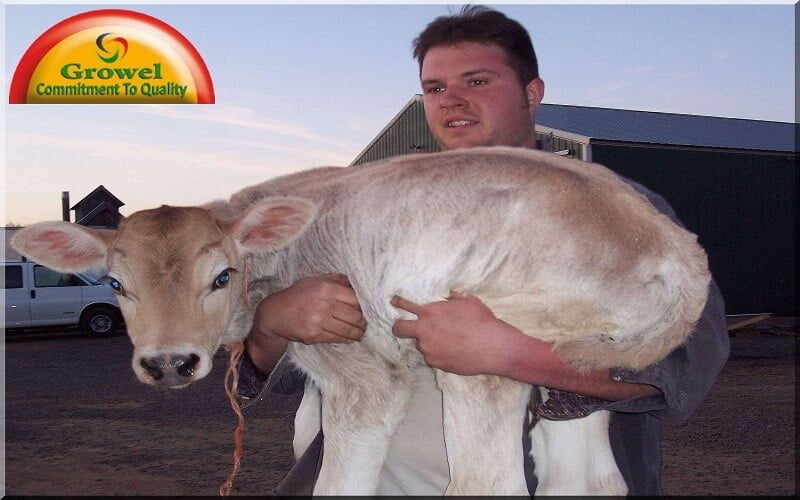 Calf Health Management of replacement animals are important components of total herd profitability. The productivity of the herd can be negatively affected by impaired growth of calves, decreased milk production of animals that experienced chronic illness as baby calves, spread of infectious diseases from calves to adult cows, increased veterinary costs, and the limited opportunity for genetic selection due to high mortality of replacement animals.
Calf Health Management of replacement animals are important components of total herd profitability. The productivity of the herd can be negatively affected by impaired growth of calves, decreased milk production of animals that experienced chronic illness as baby calves, spread of infectious diseases from calves to adult cows, increased veterinary costs, and the limited opportunity for genetic selection due to high mortality of replacement animals.
Most calf deaths are attributed to infectious disease such as scours, septicemia, pneumonia. However, non-infectious problems cause most of the losses in the first 2 to 3 days, and these problems greatly increase the risk of later infectious disease if they do not kill the calf right away. Management practices aimed at identifying and resolving these very early problems are the single most direct and cost effective way to improve calf health.
What are these early Calf Health Management ?
Typically they are physiological disturbances such as hypothermia and hypoglycemia. Dystocia is the most important single contributor to these types of problems and has been estimated to increase calf death risk by 4 to 8 fold. Although decreasing the incidence and severity of dystocia increases neonatal survival, many calves have problems at birth without dystocia. Efforts to enhance calf health and survival should include strategies for correcting physiological disturbances.
Common Aspects of Neonatal Disease:
During the birthing process the newborn is subjected to trauma and a period of low oxygen supply (anoxia/asphyxia) which are exaggerated in dystocia. Within just a few minutes the newborn must then adapt to life outside the uterus. The baby must breathe properly, remove waste products, generate heat and maintain body temperature, alter blood flow, stand, and seek food. Each aspect of this process is dependent on the others. Because all body systems are adapting, it is most common for one problem to lead to others.
Outward signs that this adaptive process is not progressing normally can be subtle: inactivity, weakness, slowness in normal behavior (standing, suckling), low body temperature, and low or erratic heart and respiratory rates. It is common for affected calves to look fairly normal for 15 to 30 minutes after delivery, but then to gradually become weaker and less responsive. Decreasing vigor or responsiveness are the first evidence of problems. Calves are remarkably resilient and can survive well if sufficient care and time are provided.
Frequently Identified Neonatal Problems :
Inactivity or lethargy: Decreased activity is characterized by delayed standing and suckling. These activities generate body heat and provide nutrition and immunological support against disease.
Hypothermia: The calf’s body temperature is usually 1 to 2 oF above the rectal temperature of the dam immediately after birth and will drop to about 102oF within 15 to 30 minutes after delivery. A sign of problems is body temperature that continues to drop below this level. Hypothermia can occur even in very warm surroundings.
Hypoxemia (Low Blood Oxygen): This is a frequent problem that arises when respiratory and circulatory systems are slow to adapt or inadequate for life outside the uterus. No animal can thrive without adequate oxygen, and this problem contributes to all of the other problems that can be seen.
Acidosis: As they exit the uterus, calves have low oxygen, low total body fluid, and mild acidosis. These self-correct if the calf breathes well, obtains fluid food, and maintains good blood circulation. Calves that are compromised at birth or suffer dystocia don’t correct these deficits, and they worsen with time.
Hypoglycemia: This is a less frequent occurrence than the other problems, but can represent a life-threatening problem to the newborn. Calves rarely develop hypoglycemia after consumption of colostrum or milk.
Poor Colostral Transfer: Calves with dystocia or other physiological problems such as hypoxemia or acidosis are prone to poor immunoglobulin protection. This is due to delayed or decreased colostrum consumption and decreased intestinal absorption with poor gastrointestinal activity.
Managing to Decrease Calf Problems :
All of these common newborn problems contribute to further calf health problems and death. Despite the fact that most of these are easily treated, and generally responsive to treatment, they are usually overlooked. Simple steps to minimize losses include:
- Develop a calf monitoring scheme.
- Provide special care to calves that are at high risk to develop problems and circumvent them before they develop.
- Promptly treat the problems that do occur.
Guidelines for Calf Monitoring :
Good mothering attention from the dam provides nuzzling and licking in order to dry the calf and encourage it to stand. In a dairy operation the calf manager provides this stimulation in lieu of the dam. Normal newborn calves may reasonably be expected to stand within one hour of birth. The calf’s body temperature should not decrease below 101oF. An active suckling reflex should be present, even before the calf has stood. The calf should remain attentive, responsive, and strongly active throughout the first two hours of life.
Assessment of the dam’s health, the type of delivery, the maturity of the newborn, and the physical and behavioral characteristics of the newborn should be recorded. Calves born from an ill dam or with any degree of dystocia, or that appear premature at birth, will have an increased likelihood of encountering problems. For the first several hours after birth, calves should be evaluated frequently.
Guidelines for Calf Care:
Calf survival is dependent on the attention of the calf manager in lieu of the dam. Calves should be promptly dried and warmed with towels and hair dryers, provided adequate shelter and supplemental heat with lamps, stimulated to move about, and suckle.
Rubbing the calf, lifting it to stand, encouraging it to walk about, providing colostrum via nipple feeder, or, if no suckle is elicited after a couple of hours, providing colostrum via esophageal intubation are all part of the duties of the calf manager.
If the calf does not appear to respond positively to these nursing care efforts, the veterinarian should be called. While additional treatments are not difficult to administer, calves which need more care should be thoroughly assessed to insure optimal results.
Calf health Management of Newborn (1 to 10 days of age):
- Clean hands, arms and equipment if assisting the calving.
- Remove mucus from the calf’s mouth and nose.
- Rub the calf vigorously if stimulation is necessary.
- Examine the navel and place a tie around the stalk if it is still bleeding or more than 2″ in diameter. Apply disinfectant to a clean navel. Iodine solutions (1, 2 & 7%) or chlorhexidine (0.5%) may be effective.
- Feed 2.5-3.5 liters of clean colostrum to the calf as soon possible; use either a bottle or esophageal tube feeder. Do not let the calf nurse.
- Inject with 3 cc Vitamin E and Selenium at birth (white muscle disease)
- Inject with 2 cc Vit A and D (calves are born with small reserves)
- Identification of calf by tattooing or other methods.
Calf Health Management of One Month Calf:
- Dehorn with electric dehorners
Calf Health Management ,2 to 5 Months:
- Monitor weight, height, body condition scores
- Continue coccidia control
- Strategic deworming
Calf Health Management 5 to 6 Months:
- Vaccinate for brucellosis
- Vaccinate with 7-way clostridium (repeat in 3 weeks)
- Vaccinate for IBR, PI3, BVD,
- Deworm
- Check for extra teats
- Measure weight, height, and body condition score
6 to 13 Months:
- Monitor weight, height, and body condition score
- Vaccinate for leptospirosis
- Vaccinate for Vibrio if natural service is used
- Deworm
Pregnant Heifers:
- Monitor weight, height, and body condition score
- Maintain sound nutritional management for adequate growth
- Maintain coccidia control and strategic deworming program
- Vaccinate against Leptospirosis at 18 to 20 months
- Vit E and selenium (Grow E-Sel) 45 to 60 days prior to freshening
- Vaccinate with E.Coli, Rota and Corona beginning 60 days prior to freshening
Disease Management:
Scours (Diarrhea)
Scours or neonatal diarrhea is the primary cause of death in unweaned calves (50 to 60%).
Primary Cause
- Infectious agents; bacteria, viruses, and protozoa (microbial diarrhea)
- Improper nutrition (Nutritional diarrhea).
Predisposing factors
- Inadequate intake of colostrum
- Using milk with high bacterial count
- Feeding milk or milk products at irregular time or irregular amounts.
- Feeding poor quality milk replacers, especially calves less than 3 weeks of age.
- Poor sanitation of feeding equipment.
- Keeping calves in dirty pens or exposed to scouring calves.
Types of Neonatal Diarrhea :
Diarrhea in newborn calves can be classified into two groups:
- Nutritional diarrhea: Results from ingesting too much milk or milk that is not properly digested (i.e. bad quality milk replacer) and overfeeding milk to hungry calves. The main cause of nutritional diarrhea is lactic acid bacteria. Excessive fermentation of sugars (e.g. lactose) in the large intestine results in the production of large quantities of lactic acid. Osmotic pressure increases and pH is lowered in the intestine. As a result, water will be drawn from the body into the intestine causing diarrhoea
- Infectious diarrhoea: Caused by infectious agents mainly E. coli. Infectious diarrhoea is the most common health problem in young calves when predisposing factors are not well-controlled. The incidence of fatal E. coli infections is high during the first two weeks of life. Affected calves that survive this period, usually recover.
Two types of E. coli infections can be identified:
- Septicemia: coli may cross the intestinal wall and enter the blood stream causing septicemia. The highest mortality occurs during the second and third day after birth.
- Enterotoxemia: coli produces toxins that cause localized intestinal inflammation. Peak mortality occurs at about 6-7 days of age.
Treatment:
The key to successful treatment of calf diarrhea is early detection and early administration of a well-balanced oral rehydration product (Electral Energy). Oral electrolyte treatment should start at the first sign of diarrhea (excretion of large volume of loose watery feces). In severe cases of dehydration (10% or more), intravenous feeding may be necessary. Scouring calves treated with an electrolyte solution should continue to receive their normal feeding of milk or milk replacer. This is because the electrolyte solutions do not contain enough nutrients to meet the energy requirements of the calf. Electrolytes solution can be classified based on the pH of the solution into alkaline and acidic electrolytes. Acidic electrolyte solution may be fed immediately after a meal of milk as they may help protein coagulation and digestion. However, alkaline electrolyte solutions are more effective when they are fed 3-4 hours after a meal, as they may interfere with milk coagulation.
Pneumonia (Inflammation of the Lungs):
Respiratory diseases occur between 4-6 weeks of age. Calves with chronic pneumonia seldom recover and should not be used for replacement. Pneumonia may vary from subclinical to acute and fatal. Rate of morbidity (incidence of disease) is high but mortality rate is quite variable. Pneumonia can be caused by bacteria (e.g. Pasteurella multocida), virus (e.g. Parainfluenza Type 3) and mycoplasma (e.g. Mycoplasma dispar).
Pneumonia usually follows other infectious diseases. The organisms associated with the disease often cannot cause clinical signs without the presence of predisposing factors.
Clinical Signs of Pneumonia :
Clinical signs are variable and are generally observed in various combinations:
- Nasal discharges
- Dry cough, especially noticeable after exercise.
- Rectal temperature > 41°C (normal temperature 39°C).
- Difficult breathing
- Lesions of the lungs.
Predisposing Factors:
- Reduced immunity and/or continuous challenge from microbes (contaminated environment).
- Poor ventilation and high relative humidity.
- Poor feeding management (overfeeding of colostrum or milk replacers)
- Poor housing management (too early weaning, too early grouping, stress due to transportation)
Treatment of Pneumonia:
Calves with pneumonia should be placed in a dry well ventilated environment. Antibiotics (Neoxyvita Forte) are usually given to reduce the effects of secondary bacterial infections.
Prevention of Pneumonia:
Reduction or elimination of predisposing factors will significantly reduce the occurrence of pneumonia. Adequate intake of colostrum, avoidance of nutritional stress, proper housing and good natural ventilation are effective ways of reducing the incidence on pneumonia. Vaccination program relevant to agents prevalent in an area may be planned under veterinarian supervision.
You should never forget to feed one most important nutritional supplements to calf that is Amino Power ,this is an Unique Combination of 46 Powerful Amino Acids, Vitamins & Minerals .This is very much helpful for faster & healthy growth ,diseases resistance, immunity building in calf . Amino Power will also do correction of Vitamin ,Protein & Minerals nutritional disorders calf . Wishing you all the best for your healthy & diseases free calf.
You should also read Importance of Vitamins and Minerals for Cattle.



